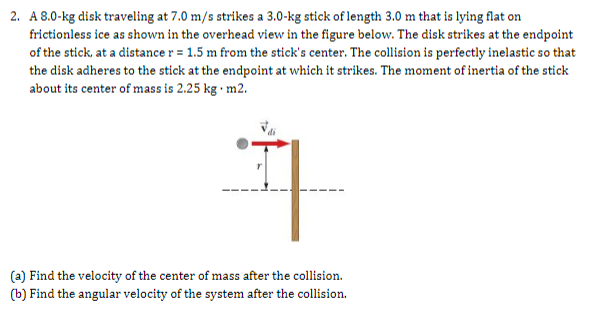2. A 8.0-kg disk traveling at 7.0 m/s strikes a 3.0-kg stick of length 3.0 m that is lying flat on frictionless ice as shown in the overhead view in the figure below. The disk strikes at the endpoint of the stick, at a distance r = 1.5 m from the stick's center. The collision is perfectly inelastic so that the disk adheres to the stick at the endpoint at which it strikes. The moment of inertia of the stick about its center of mass is 2.25 kg · m2. (a) Find the velocity of the center of mass after the collision. (b) Find the angular velocity of the system after the collision.
2. A 8.0-kg disk traveling at 7.0 m/s strikes a 3.0-kg stick of length 3.0 m that is lying flat on frictionless ice as shown in the overhead view in the figure below. The disk strikes at the endpoint of the stick, at a distance r = 1.5 m from the stick's center. The collision is perfectly inelastic so that the disk adheres to the stick at the endpoint at which it strikes. The moment of inertia of the stick about its center of mass is 2.25 kg · m2. (a) Find the velocity of the center of mass after the collision. (b) Find the angular velocity of the system after the collision.
Physics for Scientists and Engineers
10th Edition
ISBN:9781337553278
Author:Raymond A. Serway, John W. Jewett
Publisher:Raymond A. Serway, John W. Jewett
Chapter9: Linear Momentum And Collisions
Section: Chapter Questions
Problem 47AP: A 0.500-kg sphere moving with a velocity expressed as (2.00i3.00j+1.00k)m/s strikes a second,...
Related questions
Question

Transcribed Image Text:2. A 8.0-kg disk traveling at 7.0 m/s strikes a 3.0-kg stick of length 3.0 m that is lying flat on
frictionless ice as shown in the overhead view in the figure below. The disk strikes at the endpoint
of the stick, at a distance r = 1.5 m from the stick's center. The collision is perfectly inelastic so that
the disk adheres to the stick at the endpoint at which it strikes. The moment of inertia of the stick
about its center of mass is 2.25 kg · m2.
(a) Find the velocity of the center of mass after the collision.
(b) Find the angular velocity of the system after the collision.
Expert Solution
This question has been solved!
Explore an expertly crafted, step-by-step solution for a thorough understanding of key concepts.
This is a popular solution!
Trending now
This is a popular solution!
Step by step
Solved in 5 steps with 5 images

Recommended textbooks for you

Physics for Scientists and Engineers
Physics
ISBN:
9781337553278
Author:
Raymond A. Serway, John W. Jewett
Publisher:
Cengage Learning

Physics for Scientists and Engineers with Modern …
Physics
ISBN:
9781337553292
Author:
Raymond A. Serway, John W. Jewett
Publisher:
Cengage Learning

College Physics
Physics
ISBN:
9781285737027
Author:
Raymond A. Serway, Chris Vuille
Publisher:
Cengage Learning

Physics for Scientists and Engineers
Physics
ISBN:
9781337553278
Author:
Raymond A. Serway, John W. Jewett
Publisher:
Cengage Learning

Physics for Scientists and Engineers with Modern …
Physics
ISBN:
9781337553292
Author:
Raymond A. Serway, John W. Jewett
Publisher:
Cengage Learning

College Physics
Physics
ISBN:
9781285737027
Author:
Raymond A. Serway, Chris Vuille
Publisher:
Cengage Learning

College Physics
Physics
ISBN:
9781305952300
Author:
Raymond A. Serway, Chris Vuille
Publisher:
Cengage Learning

College Physics
Physics
ISBN:
9781938168000
Author:
Paul Peter Urone, Roger Hinrichs
Publisher:
OpenStax College

Principles of Physics: A Calculus-Based Text
Physics
ISBN:
9781133104261
Author:
Raymond A. Serway, John W. Jewett
Publisher:
Cengage Learning